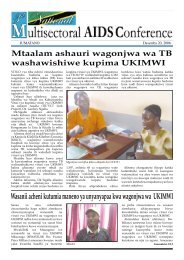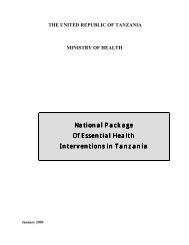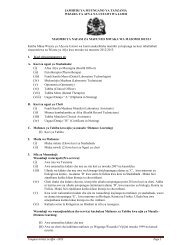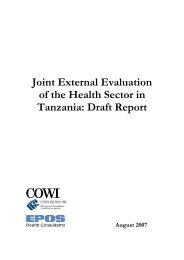Environmental and Social Management Framework for Tanzania ...
Environmental and Social Management Framework for Tanzania ...
Environmental and Social Management Framework for Tanzania ...
Create successful ePaper yourself
Turn your PDF publications into a flip-book with our unique Google optimized e-Paper software.
most cases mitigatory measures can be designed more readily than <strong>for</strong><br />
Category “A” projects. The scope of EIA <strong>for</strong> a Category “B” project may vary<br />
from project to project, but it is narrower than that of Category “A” EIA. Like<br />
Category “A” EIA, it examines the project's potential negative <strong>and</strong> positive<br />
environmental <strong>and</strong> social impacts <strong>and</strong> recommends any measures needed to<br />
prevent, minimize, mitigate, or compensate <strong>for</strong> adverse impacts <strong>and</strong> improve<br />
environmental per<strong>for</strong>mance.<br />
3) Category “C”: A proposed project is classified as Category “C” if it is likely to<br />
have minimal or no adverse environmental impacts. Beyond screening, no<br />
further EA action is required <strong>for</strong> a Category “C” project.<br />
4) Category “Fl”: A proposed project is classified as Category “Fl” if it involves<br />
investment of Bank funds through a financial intermediary, in subprojects that<br />
might result in adverse environmental impacts.<br />
The construction <strong>and</strong> rehabilitation of infrastructure under the Regional Health<br />
Systems Strengthening <strong>and</strong> TB Support Project, is likely to have no significantly<br />
adverse environmental <strong>and</strong> social impacts, which require mitigation. However, in line<br />
with the Operational Policy, this ESMF is prepared <strong>for</strong> screening of the project<br />
activities. Given that the Regional Health Systems Strengthening <strong>and</strong> TB Support<br />
Project has been classified as a Category B, the project will not fund any<br />
investments classified as Category A, based on the screening results.<br />
2.4 LEGAL FRAMEWORK<br />
Typical national legal framework relevant to the Regional Health Systems<br />
Strengthening <strong>and</strong> TB Support Project would include;<br />
• Urban Planning Act;<br />
• Health Laboratory Practitioners Act;<br />
• Water Resources <strong>Management</strong> Act;<br />
• The National Constitution of the participating country;<br />
• <strong>Environmental</strong> <strong>Management</strong> Act;<br />
Local Government Authorities (City, Municipal, District <strong>and</strong> Town Councils)<br />
<strong>Environmental</strong> Impact Assessment <strong>and</strong> Audit Regulations;<br />
Mining (<strong>Environmental</strong> <strong>Management</strong> <strong>and</strong> Protection) Regulation;<br />
The L<strong>and</strong> Act (1999) <strong>and</strong> the L<strong>and</strong> Regulations;<br />
L<strong>and</strong> acquisition <strong>for</strong> development of public infrastructure;<br />
Valuation of l<strong>and</strong> <strong>and</strong> properties <strong>for</strong> compensation;<br />
The Occupational Health <strong>and</strong> Safety Act;<br />
An example of how the above policies, legal <strong>and</strong> regulatory framework would be<br />
relevant to the Regional Health Systems Strengthening <strong>and</strong> TB Support Project <strong>and</strong><br />
the relevant areas of application is given in Annex 9, which presents the framework<br />
reviewed <strong>for</strong> <strong>Tanzania</strong>.<br />
22







